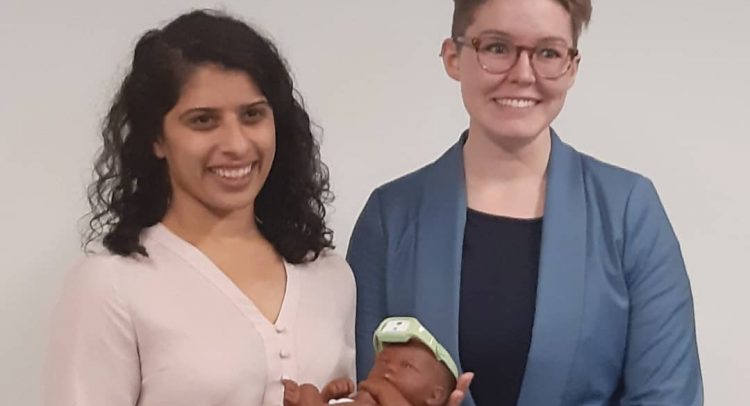Neopenda co-founders, Sona Shah and Teresa Cauvel displaying how the neopenda device works.
TWO WOMEN passionate about healthcare and engineering are in the process of creating a solution that would give patients in low-resource settings access to high quality medical care.
Their medical device startup, Neopenda, a combination of English and Swahili words – meaning Babylove – is a wearable vital science monitor for babies that helps healthcare workers better manage their fragile patients in an efficient manner.
The four in one monitoring device measures the heart rate, oxygen saturation, temperature and the breathing rate of babies and displays the vitals in real time on a tablet so healthcare providers can monitor the babies’ health statistics without having to be by their bedside.
Neopenda co-founders, Sona Shah and Teresa Cauvel, briefing journalists on the Global Entrepreneurship Summit (GES) 2019 Reporting Tour organised by the Foreign Press Centers, U.S Department of State, Bureau of Public Affairs, said their product was informed by the challenges facing low resource centers in delivering healthcare to babies.
“As part of our research for the device we visited hospitals in Uganda and we learnt that the neonatal and intensive care units have just far too many babies that need help but not enough staff and medical equipment so we tried to solve it with a technology solution,” said Ms Cauvel.
Further research has showed that Sub-Saharan Africa has the highest risk of deaths in the first month of life and is among the regions showing the least progress in reducing neonatal deaths often due to lack of medical equipment.
“Without the monitoring technology they do not know when the baby is in distress and so some die from preventable causes unfortunately,” she added.
“With the monitoring system, we can help them know what the status of all the babies in the room is and the ones that need attention more urgently,” she disclosed.
Ms. Cauvel further explained that the battery powered device uses Bluetooth and can last from five to seven days without having to recharge.
It is easy to clean, and reusable from one patient to the next, she revealed.
“One of the things we keep in mind is designing for the communities… so what we are doing that is different is that we are designing it for the setting and the emerging markets that do not have access to this type of technology,” stated Ms. Shah.
She said all four vital science statistics are shown on the dashboard for every patient that is in the room and when they are out of the range, it shows red on the dashboard and flashes red on the device to alert the nurse that there is something wrong with the patient.
“Beyond that you can click on every patient’s profile and look at the transit over time and that gives lot more guidance on what is happening with the patients in the ward and if the treatment being given is actually working or should be modified in any way,” she added.
The product which comes in a complete Bluetooth enabled package with low power system is in clinical trials in US, Boston as well as a working trial in Uganda.
From Jamila Akweley Okertchiri, Chicago Illinois. Curtesy Foreign Press Centers.


